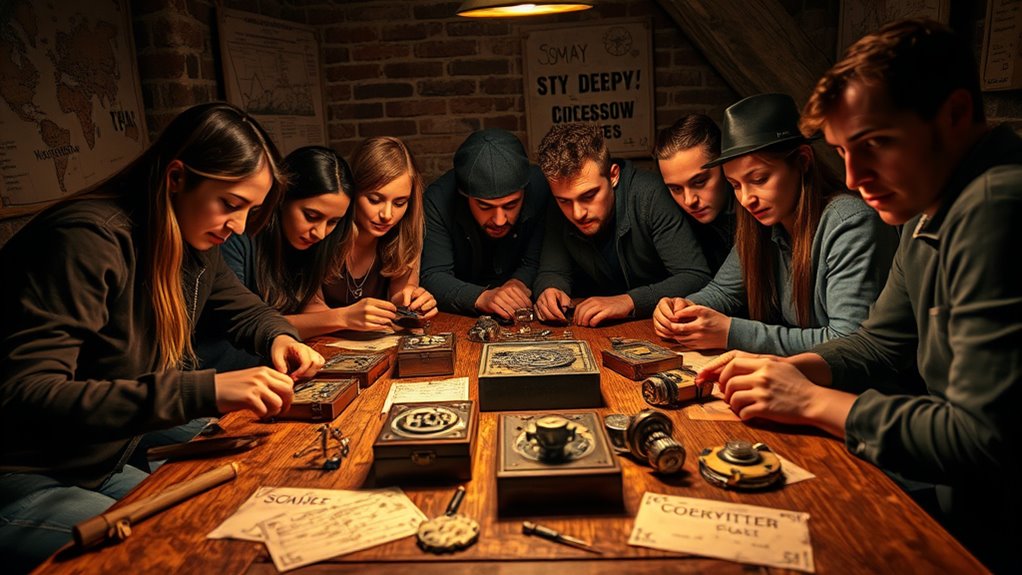In escape room design, interactivity and player engagement are key to creating memorable experiences. By incorporating immersive storytelling and cutting-edge technology like virtual reality, you can make players feel like they’re part of the story rather than just solving puzzles. This active participation encourages deeper emotional investment and exploration of details. Focusing on seamless narrative integration keeps players motivated and connected. Keep exploring to discover more ways to elevate your escape room experience even further.
Key Takeaways
- Incorporating virtual reality enhances immersion, making players feel like active participants rather than passive observers.
- Embedding narrative elements within puzzles creates meaningful connections, increasing emotional investment and engagement.
- Designing interactive environments that respond to player actions fosters exploration and a sense of agency.
- Using advanced technology allows for dynamic, responsive scenarios, maintaining player interest throughout the experience.
- Seamless storytelling integration motivates players to solve puzzles to uncover the narrative, deepening overall engagement.

Escape rooms have become an increasingly popular form of entertainment because they thrive on interactivity, immersing players in a challenging and engaging experience. To elevate this experience, designers are now leveraging cutting-edge technology like virtual reality, which transports you into entirely different worlds, making the escape feel more real and immediate. With virtual reality, you don’t just solve puzzles; you become part of the story. It allows for a seamless integration of narrative elements, where your actions directly influence the storyline, heightening your emotional investment. When you step into a VR escape room, you’re no longer just observing the narrative — you’re living it. This immersive approach encourages you to explore every detail, interact with objects naturally, and feel like you’re truly inside the story, which keeps you engaged for longer periods. Additionally, advances in interactive storytelling are enabling designers to craft more dynamic and responsive scenarios that adapt to player choices, further enriching the experience.
Narrative integration plays a vital role in making escape rooms memorable. When the story is woven into the puzzles and environment, it creates a cohesive experience rather than isolated challenges. For example, if the theme is a detective mystery, each clue you find should feel like part of the larger narrative, pushing you closer to solving the case. When designed effectively, this integration makes the puzzles more meaningful because they’re tied to the story’s context, not just arbitrary tasks. You become motivated to progress because every solved puzzle reveals more of the story, making the entire experience more compelling. Good narrative integration also fosters emotional connections, whether it’s a sense of urgency in a hostage scenario or the intrigue of uncovering a hidden secret. These elements keep you invested, enthusiastic to see what happens next.
Frequently Asked Questions
How Do Cultural Differences Affect Escape Room Interactivity?
Cultural differences considerably influence escape room interactivity by shaping how players interpret cultural symbolism and navigate language barriers. You might find that symbols or clues resonate differently, impacting engagement and problem-solving. To enhance interactivity, you should incorporate culturally relevant themes and guarantee language barriers are minimized with clear visuals or multilingual support. This approach makes the experience more inclusive, allowing players from diverse backgrounds to fully participate and enjoy the challenge.
What Are the Latest Technological Innovations in Escape Room Design?
You explore the latest innovations in escape room design, where augmented reality and immersive technology revolutionize your experience. You wear AR glasses to see hidden clues, interact with virtual objects seamlessly, and immerse yourself in a story that feels real. You *uncover* puzzles that respond dynamically, creating a personalized adventure. These technological advances heighten your engagement, making each escape room journey more interactive, memorable, and thrilling than ever before.
How Can Escape Rooms Cater to Players With Disabilities?
You can make escape rooms accessible by incorporating adaptive accessibility features and embracing inclusive design principles. Use tactile clues, visual aids, and adjustable controls to accommodate diverse needs. Guarantee pathways are wide enough for wheelchairs, provide clear signage, and include sensory-friendly options. By prioritizing these elements, you create an inclusive environment where all players, regardless of ability, can fully participate, enjoy, and be challenged by your escape room experience.
What Role Does Storytelling Play in Enhancing Engagement?
Storytelling plays a compelling role in enhancing engagement by creating narrative immersion, drawing you into the escape room’s world. As you follow the story, you develop an emotional connection with the characters and plot, making the experience more captivating. This emotional investment motivates you to solve puzzles and progress, heightening your overall enjoyment. Strong storytelling transforms a simple challenge into an immersive adventure that keeps you engaged from start to finish.
How Is Player Feedback Integrated Into Design Improvements?
Think of your escape room like a garden that needs tending. You gather player surveys and post-game reviews, which act as your watering can, providing essential insights. By analyzing this feedback, you identify what’s blooming and what’s withering. You then prune or nurture elements of your design accordingly, ensuring future players enjoy a more engaging experience. Your responsiveness keeps the game fresh, lively, and ever-evolving, just like a thriving garden.
Conclusion
By focusing on interactivity, you create an immersive experience that keeps players hooked, much like how a well-designed app captures your attention amid the chaos of daily life. Engaging puzzles and dynamic environments foster teamwork and excitement, ensuring players stay invested from start to finish. Remember, a truly memorable escape room is like the first episode of a binge-worthy series—leaving them enthusiastic for more, even if it means risking a few “ctrl+z” moments in the process.









